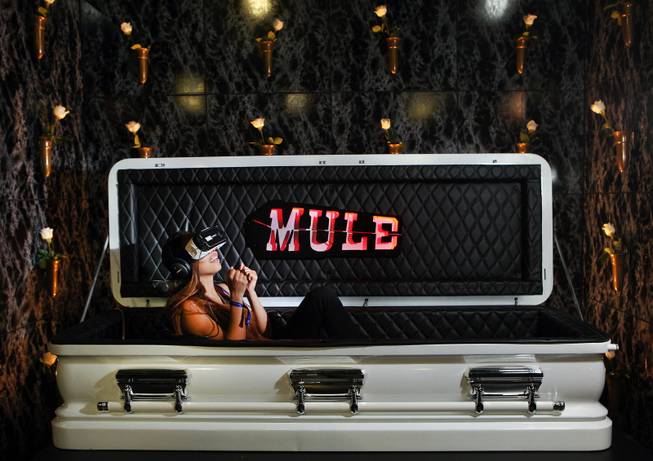
Ashely Warnick of Los Angeles, California, reacts to the darkness of the Mule 360 Video Project while sitting in an actual casket during the Virtual Reality Festival featuring exhibits/demos and panel discussions at the Las Vegas Production Studios on Friday, Jan. 6, 2017.
Monday, Jan. 16, 2017 | 2 a.m.
"People will get married in virtual reality,” she tells you.
You’re at Level Up inside MGM Grand, having met at the new gaming lounge a few minutes ago. In her vision, as best you can tell, a 3-D scan of the bride and groom will be loaded into a virtual world. Guests will be invited to watch from anywhere as the avatars take vows in “lavish” environs. Palatial décor with a diamond as big as the Ritz, that sort of thing. The technology isn’t there yet, but she tells you it’s coming.
Perhaps it could. Consider that a Florida startup is offering couples 360-degree footage so they can watch and rewatch their weddings from inside the moment.
“I want to get married in virtual reality,” Laura Hall adds.
In a thick Southern drawl, Hall introduces herself as The Virtual Reality Girl, the handle for her business and blog. This night — the first of VR Fest during CES week — she’s an evangelist for the nascent industry. VR will be used in courtrooms and classrooms, she says. “Think about people sitting at the bar right now.” Level Up’s patrons, huddled around TVs like Norm from “Cheers,” will one day gaze into headsets that drop them in the backfield as the New York Giants play.
What this scenario does to alcohol consumption is an open question, apparent in watching the fumbling handoff of a cocktail to someone whose face is enveloped in a VR headset.
Dozens of people wearing the clunky black devices wander around the lounge, periodically craning their necks. They’re demoing games through VR Fest, the annual three-day gathering billed as the largest and first virtual reality festival. Behind the lenses, they are satisfying one of entertainment’s most cathartic goals: escape. To enter alternate realms ranging from the documentary to the fantastical.
Of course, that’s also a goal of tourism and Las Vegas, which appropriates the Eiffel Tower, the Statue of Liberty, Venetian canals and pillars of ancient Rome on a single street. So while these demos are a one-night affair for the Level Up lounge, MGM and other casino operators are discussing how to integrate the headsets as a virtual reality scene emerges in Las Vegas. With three brick-and-mortar VR arcades scheduled to launch this year, the technology might have found a cultural partner.
• • •
Wednesday afternoon, before the festival. If VR is in its youth, VR Fest, which debuted in Los Angeles three years ago, is an infant developing motor skills. Founder Chris Crescitelli, a filmmaker from the world of 3-D cinema, moved the event to Las Vegas last year to coincide with CES.
Despite virtual reality content popping up in industries ranging from education to medicine, little is made here. Local production studios include Wemersive, with offices in Las Vegas, Los Angeles and Amsterdam, and Blackwood VR in Henderson. But Eric Preiss, who directs the Nevada Film Office, says no virtual reality shoots have registered for state permits.
The office is backing VR Fest for the second year. “Our decision to work with Chris was out of anticipation of what’s to come,” Preiss says. “We hope to continue that relationship and see a big increase in the amount of VR that’s going to happen here.”
The event’s mission is to “introduce audiences around the globe to the magic and excitement of the virtual reality experience, while shining the spotlight on the virtual pioneers ...”
“Oh, yeah, I’m busy,” says Crescitelli, who seems to fully embrace virtual reality’s frenetic promise to deliver everything and more. In May, he plans to debut VR Fest in China, and later in the year, he expects to open VR Arcade in Las Vegas, a pop-up gallery of virtual reality demonstrations in a 22,000-square-foot space on the Strip.
How VR headsets work
LENSES: VR headsets use a stereoscopic display. That means each lens offers a view of the same scene from slightly variant angles, tricking the eye into seeing depth and making an image seem 3-D.
360-DEGREE WORLD: Software and videos in virtual reality are designed to extend the world beyond the immediate field of vision, helping users believe they are engulfed in an alternate environment.
HEAD TRACKING: Using tools like a gyroscope (which allows the axis of rotation to assume any orientation) and accelerometer (which measures acceleration forces), this system within the headset makes the VR world appear responsive to head movements. Tilt your head down or up and the image in virtual reality shifts accordingly.
HAND CONTROLLERS: Some virtual reality brands offer handheld controllers with a trigger and buttons. The controller tracks the movements of hands, becoming a gun in a shooting game or a brush in an art program.
Crescitelli’s events embrace the nightlife side of Las Vegas and CES (convention afterparties this year featured headliners such as Sting and Blink-182). VR Fest has taken over Light and Hakkasan, and it’s about to host at Hyde. The tech, while innately isolating (at least for now), lends itself to this kind of rapturous shared human experience.
“I’m taken by the way that VR works as an empathy machine,” Crescitelli says.
Efforts to examine the nature of reality are about as socially enduring as language. Recent VR projects have paid homage to material as ancient as Plato’s “Allegory of the Cave” and as modern as 21st-century science fiction.
But with the exception of military and industrial applications, virtual reality has long been an aspirational exercise. Many still think it’s overhyped, poised to fade out and never penetrate the mainstream. But it’s gaining traction in commercial markets, especially as Facebook, Samsung, HTC, Sony and other consumer-tech companies back high-profile projects. A turning point for the industry came in 2014, when Facebook purchased Oculus and its headset for $2 billion. Expanding the market for VR further, Samsung announced at CES that it had sold more than 5 million headsets. When AVN’s Adult Entertainment Expo rolls through town this week, VR will have a presence (Southern Nevada’s brothel industry makes for an interesting tug between VR’s potential for disruption and for business expansion).
The challenge now is as much about content as it is about hardware, says Jack McCauley, an Oculus co-founder. Virtual reality needs a hit, something to go viral, McCauley adds. “There has to be a really good game to play.”
• • •
Friday at noon. It’s the second day of CES and VR Fest, but Nathan Rowe’s team is occupied on the second floor of Work in Progress, a coworking space in downtown Las Vegas. Monitors and headsets clutter their pod.
The team is perfecting SculptrVR, software allowing virtual reality users to design landscapes. Think of a 3-D version of Microsoft Paint that you can walk around in, or hang-glide in.
Rowe is setting up a demo for you. Once the headset is secure, he gives you two hand controllers, and the world before you is interminable space. In your right hand is a paintbrush; in your left hand is a palette. Pull the right trigger, and you start laying your world’s foundation (it’s brickwork). Switching tools, you experiment with the delete button (a rocket launcher). You teleport. Your stomach drops as you glide from nerve-wracking elevations, racing through trees and a ravine. Nothing in reality looks this crude. The Audubon Society catalogs no flora or fauna constructed from small square blocks.
Yet it still feels realistic. A rush of paint spews out as you tilt your focus on the unbounded grid. That distorted, sustained realism is what makes you “experience” the game rather than simply interact with it.
A graduate of UNLV’s math department, Rowe started SculptrVR in September 2015 as a weekend project. He now has four full-time employees and says there is a surprisingly large talent pool in Las Vegas for development of virtual reality gaming.
“Most of them are working in casino gaming,” he says. “But it’s a lot of the same skills.”
SculptrVR is looking at how it wants to expand. Although Rowe did not disclose how many times the $20 app has been downloaded, he says a SculptrVR freebie released in October was downloaded 11,000 times.
Rowe knows only a handful of local developers working on VR projects. He suggests talking to Phil Johnston, co-founder of virtual tour company Virt.
Types of tech
MIXED REALITY: A hybrid world in which digital and physical objects interact
VIRTUAL REALITY: A 360-degree environment that immerses the user in another location
AUGMENTED REALITY: Technology that projects digital images on the real world (i.e., Google Glass)
You find Johnston at VR Fest, presenting an early version of his product on a soundstage. More than a dozen companies are spread across the dark plane, underneath fluorescent studio lights, a laser show and pop’s tin blare. A remix of Rihanna’s “Love on the Brain” comes on as attendees demo everything from mixed reality lenses that alleviate eye strain to a horror film that lets you choose to be cremated or buried alive.
Johnston started his company in New York, participated in an accelerator in San Francisco and moved to Las Vegas about a year ago to avoid the cost of Bay Area rent. He has found the tech scene small in comparison. “You have ScupltrVR,” says Johnston, who works out of the SYN Shop hackerspace. “There are a couple of 360-(degree) production companies. But the community is smaller than it should be.”
With Virt, he hopes to help hotels and real estate agencies showcase properties. A rover with a 360-degree camera will take images of a site, and Virt will construct a 3-D tour. Virtual reality proponents see this type of observational application as a way to make the rarefied an everyday experience. Visit Mount Rushmore or Stonehenge or Mars or Hawaii or Machu Picchu or the Egyptian pyramids. Visit your dream home. Gather with friends in a virtual grotto. Some companies, including Oculus, are working to reach this market.
It could remove barriers to experience. Or distort it. As with any new technology, there is talk about the dystopian vision of virtual reality, one that sequesters and ultimately changes the human character. Of course, respected theorists made similar declarations about novels in the 19th century, then radio, television, video games and the internet. You never live in the moment. You are distracted. You are more selfish. You are alone.
• • •
Later Thursday night. But what the hell is reality, anyway?
We are five days past 2016, the year that use of the term “post-truth” increased by 2,000 percent. As the truth flexed, virtual reality got hype — industry analysts said 2016 would be the year it no longer was a dream of the ’90s. And many believed.
Crescitelli does. So does The Virtual Reality Girl, saying the technology could be utopian, and become ubiquitous. “It’s going to be like cellphones,” she tells you.
True surrender to synthetic worlds will require that content meet a much higher standard, or that users cultivate a lower threshold for suspending disbelief. Right now, “virtual reality” often is a dissonant experience, a term not to be taken literally. We’re not there yet.
We’re still here, at Level Up. You are swimming with a National Geographic diver off the coast of Belize, conscious that there’s no neoprene bodysuit, no pressurized scuba tank, no water squeezing your temples as you descend into the coral structures of Glover’s Reef.
You are still in a casino, an illusion of another kind. Others are shuffling around, some dragging thick cords connected to computers, the visual smacking of an alien movie. But you see the potential. You feel it.
You step into a music video for “Old Friend,” a popping Future Islands song. You’re at the center of an endearing psychedelic animation, having transformed into an absurd Gumby creature surrounded by other absurd Gumby creatures, anthropomorphic mountains and a puckish conductor twirling a baton. You look down and see you’re moving your noodles-for-arms. You’ve forgotten how you look on the outside, and you do something you would normally never do inside a casino bar on a Thursday: dance. That is VR.
“Everyone dances,” a presenter says.
• • •
Sunday afternoon. VR Fest is over. CES is almost over.
What’s clear is that even as casinos explore opportunities to make virtual reality a main attraction on the Strip, there’s a struggle over how to make the technology more social.
“Billions of dollars are being spent on the technology side of VR,” says Jonathan Bricklin, co-founder of New York pingpong lounge SPiN. “It’s necessary. But not enough time is being spent on the delivery.”
Bricklin, who moved to Las Vegas last year, hopes to bring SPiN’s table-tennis-in-a-bar model to virtual reality. His first move: open a 17,000-square-foot lounge adjacent to the Strip in October.
His concept for social VR — dubbed 100 Monkeys — includes about 50 virtual reality portals, a sports bar and five premium experiences, including a first-person shooter game, a race simulator, a terminal for creating art and a red-light district. Bricklin is still sorting things out, like how to drink alcohol, escape to a virtual world and engage with friends all at once.
Why the name? It’s a play on the colloquialism that once 100 monkeys learn a new behavior, it spreads. And the VR business is spreading.
Zero Latency, a virtual reality startup based in Melbourne, Australia, plans to establish a presence in Las Vegas by this summer. The free-roam experience puts players in a thicket of zombies. “We think it makes sense for a bunch of reasons,” Bob Cooney, head of global business development, says of the potential move.
Crescitelli expects his VR Arcade to open at an existing Strip property by the end of the year. “Vegas is a great place to debut real-world experiences that are highly creative and highly technical,” he says. “You can see MGM getting excited about. You can see Caesars getting very publicly excited about it.”
The Linq is home to VR Adventures. Offerings include a jaunt in a haunted house, a ride on a roller coaster and a flight as a superhero, among other $20 fantasies. When they’re done, participants can buy videos of themselves experiencing VR, a twist on the theme-park model of selling photos of roller-coaster face.
• • •
Saturday night. VR Fest’s closing party is superhero-themed. Crescitelli is wearing a red cape.
You’re inside downtown’s Red nightclub, talk-shouting under cinnamon-hued lights. He introduces you to David Rosen, a local composer demoing his VR video.
You talk outside. It’s 10:56 p.m. on Fremont Street. Rosen tells you about a 2015 project, a VR music video for his composition “An Unseen Sky” that he says was the first in the medium, beating Icelandic popstar Björk’s by one week.
Rosen, who is coming out with a new 360-degree work called “Constellations,” says the music video is a good format for virtual reality, which lends itself to short, visually striking content meant to impress a sense. He describes his latest as “a real trippy version of a planetarium.”
The desert tonight is a crisp 47 degrees. Groups weave in and out of the bars along Fremont, their voices punctuated by the intermittent blast of the flame-throwing praying mantis at Container Park. You are here, and that’s what I see as the data pours in.
-
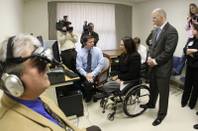
Dr. Patrick McGrath of Alexian Brothers Hospital Network demonstrates a 3-D PTSD virtual reality combat simulator.
How might virtual reality impact our lives?
Although the gaming industry encourages much of the research and development surrounding virtual reality, the technology has a broad range of applications.
Health care: Providers see many opportunities to use virtual reality in training surgeons and treating PTSD, anxiety disorders and autism.
Built environment: Architects are simulating construction projects, and historians are building walkthroughs of monuments and archaeological excavations.
Classrooms: Already there are several companies dedicated to offering VR in the classroom. “Planet Earth” sage Sir David Attenborough works with one company to take students through the Great Barrier Reef.
Assisted living: Facilities for seniors and the disabled see virtual reality as a way to connect the homebound with the outside world.
Sports: The NFL and Google announced a partnership in November to produce a nine-part virtual reality series. During the current NBA season, one game per week is being broadcast in virtual reality through the league’s digital arm.
-
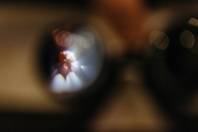
A look through a VR headset at KA The Battle Within, a gravity-defying virtual reality saga inspired by the shows storyline and martial arts at MGM Grand on Nov. 23, 2016. KA The Battle Within was featured at the Toronto International Film Festival in September as part of the official selection of the festivals Cutting Edge POP VR lineup and is now available on Samsung Gear VR powered by Oculus.
How can I try virtual reality?
Google Cardboard: The $15 foldable VR viewer allows users to play games and enter immersive worlds without the expense of a head-mounted display. The cardboard viewer runs on a smartphone, and it provides a good introduction to the medium.
VR Headset: Some are as cheap as $100 and others are as costly as $800. Popular headsets include the Oculus Rift, HTC Vive and the Samsung Gear. Some games are only available on particular headsets.
Take a virtual tour of Las Vegas:
After CES 2016, the Las Vegas Convention and Visitors Authority began filming a virtual reality “experience” to showcase Las Vegas to potential visitors. Launched last spring, it has been downloaded 18,000 times, said Nick Mattera, senior director of digital engagement.
“Virtual reality in the travel space makes a lot of sense,” he said.
While it’s difficult to track how many visitors booked travel because of the app, LVCVA has partnered with several brick-and-mortar stores to expand virtual reality’s reach. Last year, it had a deal with Virgin Holidays to offer Las Vegas’ virtual reality experience in more than 20 stores, and it had a similar partnership with Flight Centre, an Australia-based booking company with stores worldwide.
Virtual reality, Mattera said, is generally becoming more prevalent in daily life. “We will see that translate more and more into brick-and-mortar operations,” he said during CES. “If there is a way to integrate it into our building that makes sense, we’ll certainly look at that.”
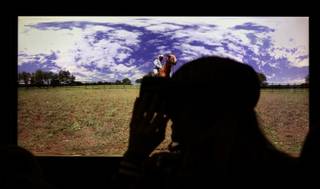
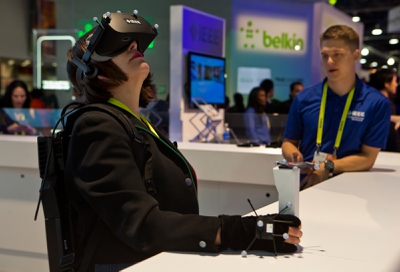
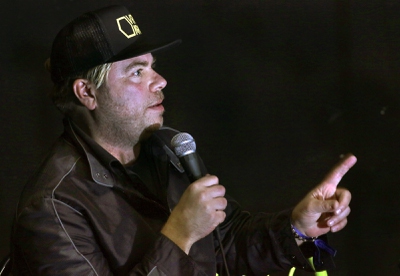
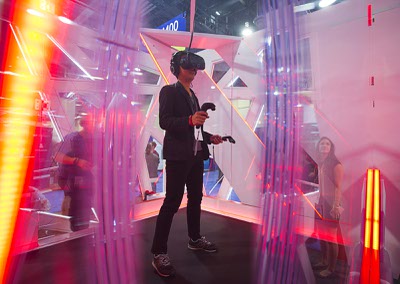



Join the Discussion:
Check this out for a full explanation of our conversion to the LiveFyre commenting system and instructions on how to sign up for an account.
Full comments policy